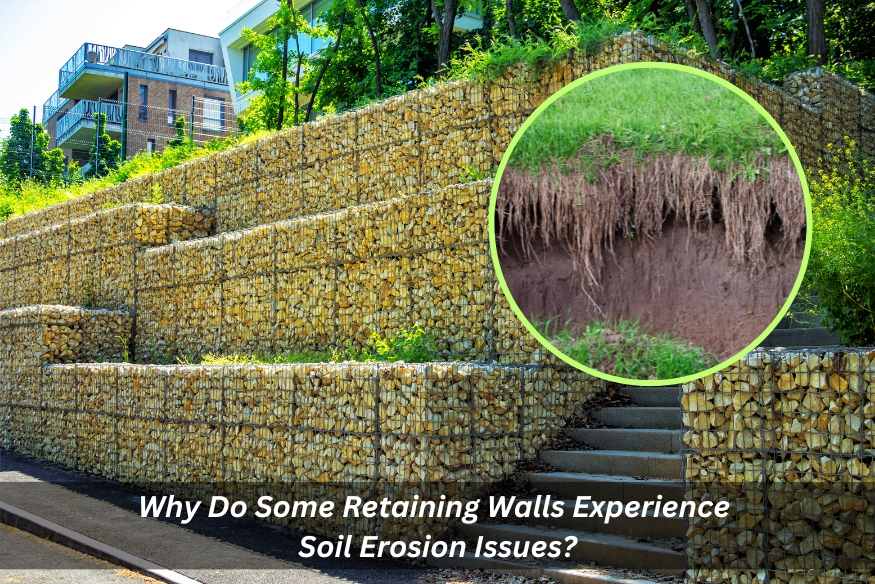
Retaining walls, those sturdy structures that hold back soil and prevent erosion, are an integral part of many landscapes. They provide stability, enhance aesthetics, and protect property from potential damage. However, even these resilient structures can fall prey to the relentless forces of soil erosion. Understanding the causes of soil erosion in a retaining wall is essential for proactive prevention and timely remedial measures.
The dynamics of soil erosion in retaining walls
Soil erosion is a natural process that involves the detachment and transport of soil particles by water, wind, or other natural forces. In retaining walls, soil erosion occurs primarily due to the accumulation and movement of water behind the wall. This water can originate from rainwater, groundwater seepage, or irrigation systems.
What are the causes of soil erosion behind retaining walls?
Several factors can contribute to soil erosion in retaining walls, each playing a role in undermining the wall’s structural integrity:
- Inadequate drainage: Proper drainage is paramount for retaining wall stability. When water accumulates behind the wall, it exerts hydrostatic pressure on the retaining wall, causing the soil to swell and soften. This weakened soil structure is more susceptible to erosion.
- Improper backfill: The type and compaction of soil used as backfill significantly impact retaining wall stability. Backfill material should be well-drained, free from excessive clay or organic matter, and properly compacted to provide adequate support. Using inappropriate backfill can lead to soil movement and erosion, compromising the wall’s structure.
- Vegetation: While plants can enhance the aesthetics of retaining walls, their roots can exert pressure on the wall, especially when they grow excessively or penetrate deep into the backfill. This root pressure can destabilise the soil and increase the risk of erosion.
- Freeze-thaw cycles: In regions with fluctuating temperatures, freeze-thaw cycles can have a detrimental impact on retaining walls. As the soil freezes and expands, it can stress the wall, causing cracks and weakening its structural integrity.
- Waterproofing failures: If the waterproofing membrane or coating on the back of the retaining wall fails, water can penetrate the wall, leading to soil erosion and structural damage.
- Excessive soil moisture: Overwatering or poor drainage can lead to excessive soil moisture, which can increase the likelihood of soil erosion.
- Poor construction practices: Improper construction techniques, such as inadequate foundation preparation or insufficient reinforcement, can make retaining walls more susceptible to erosion.
- Heavy traffic or vibrations: Heavy traffic or vibrations near the retaining wall can cause soil compaction and settlement, increasing the risk of erosion.
How to identify these issues in retaining walls?
Early detection of soil erosion issues is crucial for preventing catastrophic failures. Common signs to watch for include:
- Visual signs of erosion: Cracks, leaning, and bulging in the retaining wall are visible indicators of potential problems. These defects suggest that the wall is under stress and may not be able to withstand further erosion.
- Drainage problems: Water pooling or seeping behind the retaining wall is a red flag. This indicates that drainage is inadequate, allowing water to accumulate and weaken the soil structure.
- Vegetation growth: Excessive plant growth or roots pushing against the wall are causes for concern. Root intrusion can compromise the backfill material, increasing the risk of soil erosion and structural instability.
- Structural integrity concerns: Signs of movement, such as cracks widening or the wall leaning more noticeably, indicate structural deterioration that requires immediate attention.
What measures can prevent soil erosion in retaining walls?
By taking proactive measures, homeowners and property managers can effectively prevent soil erosion in retaining walls:
- Proper drainage systems: Installing French drains or weep holes along the base of the wall allows water to escape freely, preventing hydrostatic pressure buildup and soil erosion.
- Suitable backfill material: Use well-drained, compacted granular soil as a backfill. Avoid clay-rich or organic soil, as these retain moisture and can weaken over time.
- Vegetation control: Manage plant growth around the wall to prevent excessive root intrusion. Choose shallow-rooted plants and trim them regularly to minimize pressure on the structure.
- Regular inspections and maintenance: Schedule regular inspections to identify any signs of erosion or structural damage. Promptly address any issues to prevent them from escalating.
- Waterproofing membranes: Apply a high-quality waterproofing membrane to the back of the retaining wall to prevent water penetration and erosion.
- Proper soil moisture management: Avoid overwatering and ensure adequate drainage to maintain optimal soil moisture levels.
- Careful construction practices: Employ skilled contractors and follow established construction guidelines to ensure the
What should be done if a retaining wall suffers from soil erosion?
If a retaining wall is already experiencing soil erosion, prompt action is necessary to restore its structural integrity and prevent further damage. The following steps outline a comprehensive approach to addressing soil erosion in existing retaining walls:
- Assess the extent of damage: Evaluate the severity of the erosion and the structural integrity of the wall. This may involve visual inspection, probing the soil behind the wall, and consulting with a professional engineer for a thorough assessment.
- Seek professional advice: Engage a qualified retaining wall specialist to provide expert recommendations for repair or replacement. Their expertise will be invaluable in determining the appropriate course of action and ensuring the long-term stability of the retaining wall. While DIY repairing may be advisable for homeowners with minor retaining wall issues, it is crucial to seek professional assistance when the damage is more severe.
- Implement repair or replacement measures: Follow expert guidelines to address the erosion damage and restore the retaining wall’s stability. This may involve:
- Soil remediation: Excavating and replacing eroded soil with well-drained, compacted backfill material.
- Drainage improvements: Installing or upgrading drainage systems to prevent water accumulation behind the wall.
- Structural reinforcement: Adding reinforcement bars, concrete patching, or other structural elements to strengthen the wall.
- Partial or complete wall replacement: In some cases, severe erosion may necessitate partial or complete replacement of the retaining wall.
- Vegetation management: Remove or relocate plants with excessive root growth that could further compromise the wall’s stability.
- Regular monitoring: Maintain regular inspections and maintenance to ensure the integrity of the repaired or replaced wall and prevent recurrence of erosion issues.
Bonus tip:
In cases where extensive root growth has caused significant structural compromise to the retaining wall, consulting with Melbourne tree removal experts for retaining wall health may be necessary. They can evaluate the situation and determine if tree removal is essential for the stability of the wall.
Conclusion
Retaining walls play a crucial role in landscaping, providing stability, enhancing aesthetics, and protecting property from erosion. By understanding the causes of soil erosion in retaining walls, identifying signs of erosion early, and implementing proactive prevention measures, homeowners and property managers can ensure the longevity and safety of these structures. Remember, regular inspections and prompt action when necessary are key to maintaining the integrity of retaining walls and safeguarding your property.
Additionally, early signs of root intrusion from nearby trees may include cracks in the wall or bulging near the base. If you suspect root damage, it’s crucial to address the issue promptly. Consider consulting an arborist in Melbourne to assess the situation. They can identify the specific tree causing the problem, recommend root management strategies, and determine if tree removal is necessary.
Soil erosion in retaining walls can lead to serious structural problems and property damage. At All Green Gardening & Landscaping, we understand the importance of maintaining the stability and longevity of your retaining walls. Our team of experienced professionals can help you identify signs of erosion, assess the extent of damage, and implement effective repair or replacement measures. We use high-quality materials and follow industry best practices to ensure your retaining walls are resilient against erosion. With All Green Gardening & Landscaping, you can rest assured that your property is protected from the damaging effects of soil erosion. Contact All Green Gardening & Landscaping today for a free consultation and quote.
